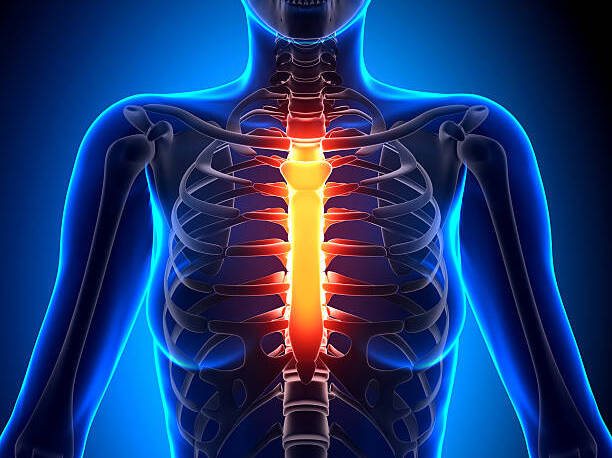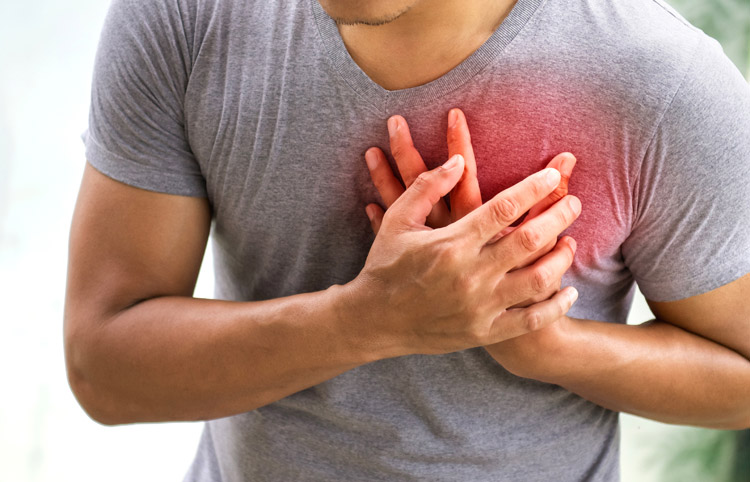Chest pain is a frightening condition but not always life-threatening. Costochondritis causes inflammation of the cartilage connecting the ribs forming the ribcage. Pain caused by this inflammation could mimic the pain caused by heart attack or other heart conditions.
Costochondritis is also referred to as chest wall pain, costosternal syndrome or costosternal chondrodynia. A rare condition in which the pain is accompanied with swelling is known as Tietze syndrome. The chest pain happens suddenly spreading to the arms or shoulder causing swelling and pain at the junction of ribs and breastbone.
The inflammation is caused in the area of your upper ribs joining the cartilage. This holds them to your breastbone. These areas joining ribs to the cartilage are called costochondral junctions.
COSTOCHONDRITIS CAUSE
Rib Cage consists of bones and cartilage. Cartilage serves as an elastic bridge that joins the bony portion of the rib to the sternum. According to this joint to sternum bones are classified as true ribs (articulate directly to sternum), false ribs (indirectly articulate to sternum through costal cartilage) and floating ribs (do not articulate with sternum).
There is not a single cause of costochondritis. It is believed to be linked to series of conditions like:
- Injury or trauma caused of the chest due to sudden impact from a car accident or fall
- Physical strain caused due activities like heavy lifting or strenuous exercise
- Viral, bacterial or fungal infection or respiratory conditions like Covid-19, tuberculosis or syphilis. These might cause joint inflammation
- Could be linked to specific problems like osteoarthritis, rheumatoid arthritis or ankylosing spondylitis
- Tumors caused in the costosternal joint region
- Large breast size
- Chest wall surgery like cardiac bypass
It can occur in children as well as adults. Women are more prone to costochondritis than men. It can develop in people suffering from fibromyalgia.
COSTOCHONDRITIS SYMPTOMS
The pain caused by the inflammation of the costochondral joints mimic the pain caused by heart attack or other medical conditions like lung disease, gastrointestinal problems and osteoarthritis. The primary symptom is sharp pain and tenderness in the chest wall. Some other symptoms are:
Sharp pain in the front of your chest at the junction of the breastbone and ribs·(most likely fourth, fifth, and sixth ribs). This is on the left side of the chest travelling to the back or belly.
Pain may worsen while breathing or coughing and reduces when the movement is restricted or breathing is slow.
Distinguishing symptom from other heart conditions is a feeling of tenderness when you press on the rib joints.
Infection caused after surgery leads to redness, swelling, or pus discharge at the site of the surgery.
Doctors would assess the chest pain thoroughly to look for tenderness along with pain. Tenderness and chest pain helps to determine costochondritis. They would also look for any infection like viral, bacterial or fungal. They would also recommend tests like X-ray, EEG and blood tests to rule out coronary artery disease or other heart conditions.
COSTOCHONDRITIS TREATMENT
Costochondritis is not life-threatening and you would usually get better within a few days on your own without any treatment. However, sometimes it may last from several weeks to months. In case of severe pain doctors would recommend a combination treatment as below.
Medication – Physicians would prescribe painkillers along with antidepressants and anticonvulsants to treat the pain along with other symptoms.
Non-steroidal anti-inflammatory drugs (NSAID) – Painkillers like ibuprofen (Motrin IB) or naproxen sodium (Aleve) are available over-the-counter. If you do not get relief from these OTC medicines doctor would prescribe these NSAID to treat pain and inflammation.
Narcotics – The pain might range from mild to severe. Mild pain gets reduced with OTC and NSAID medicines. For severe pain doctors might prescribe opioids or other narcotic medicines like hydrocodone/acetaminophen (Vicodin, Norco) or oxycodone/acetaminophen (Tylox, Roxicet, Percocet). These medicines if taken for a long duration can be addictive.
Antibiotics – These are prescribed when costochondritis is caused by infection of bacteria, virus or fungi. Antibiotics help fight the infection and reduce the inflammation that causes the pain.
Antidepressants – The pain might be chronic, lasting from several weeks to months. Antidepressants like tricyclic antidepressants (amitriptyline) help in reducing pain which keeps you awake at night.
Anti-seizure medicine – These medicines help in treatment of epilepsy. However, these have proven to provide relief in chronic pain. Anticonvulsants like gabapentin (Neurontin) control chronic pain.
Therapy – Medication along with physical therapy would provide quick relief from pain.
Stretching exercise – Heavy exercise might cause costochondritis but simple and gentle stretching exercises would help reduce the chest pain. Exercise helps increase the range of motion. You might not feel the pain while doing exercises like rotation exercises for the thoracic spine, but might feel it later.
Nerve Stimulation – This procedure is called transcutaneous electrical nerve stimulation (TENS). It uses a device that sends a weak electrical current by attaching adhesive patches on the skin near the affected area of pain. The current interrupts or masks the pain signals that prevent them from reaching your brain.
Hot or cold therapy – Applying warm compress to the sore area would help reduce the pain. Heat and cold compressions are both effective in reducing the overloading of muscles and lessen the pain. Vapocoolant spray can also be used on the affected areas as it can provide relief in the pain on the chest.
Thoracic manual therapy – This helps in stretching of the lateral and posterior rib structures that improves rib and thoracic spine mobility thereby relieving the pain.
Surgery – If the medication and therapy do not provide relief to the patient they would be injecting the numbing medication and corticosteroid directly into the affected painful joint.
In some major cases, intercostal nerve block is injected with local anaesthetic medicine around the painful ribs. This blocks the intercostal nerve as well as temporarily disrupts nerve impulses to stop the pain.

COSTOCHONDRITIS PREVENTION
Prevention is better than cure. Costochondritis is not-life threatening and usually goes away on its own. However, long-term pain due to costochondritis can be debilitating if not treated on time. The pain may arise during treatment if you are not careful while engaged in exercise or certain daily activities. Thus, proper treatment along with rest is necessary to make sure costochondritis does not affect your daily activities and quality of your life.
Minimizing the activity that provokes the pain is important like frequency and intensity of exercise to be reduced, avoid lifting heavy things and proper care after a surgery to avoid infection.
OUTLOOK
The prognosis for costochondritis is usually very good. Mostly the cases are mild and recover reasonably speedily. Speedy recovery happens with or without OTC and other common medications. Majorly in all cases, the condition has completely recovered within a year. Occasionally I might last longer than a year. There are chances it may reappear; however, this is unlikely.
Noninfectious costochondritis would recover on its own, usually with or without anti-inflammatory treatment. However, infectious costochondritis responds better to IV antibiotics and surgery and the recovery may take a long time.

